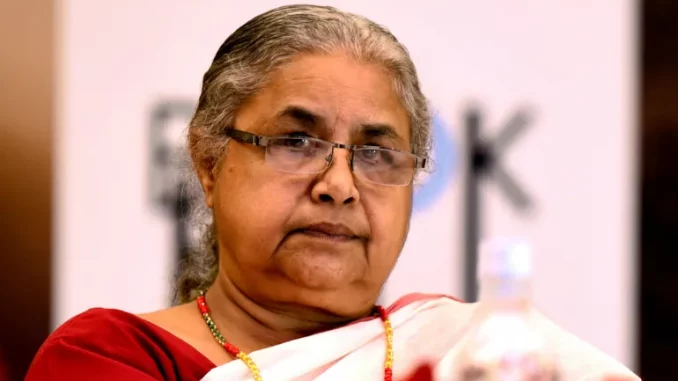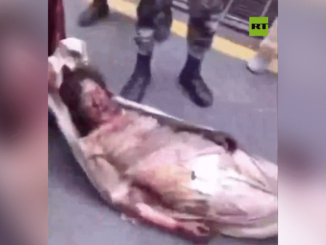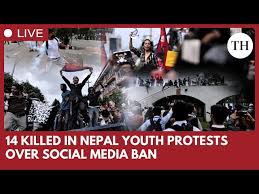
Nepal’s former Chief Justice Sushila Karki looks on during the launch of her autobiography “Nyaya” at a ceremony in Kathmandu, Nepal, on September 22, 2018. [Stringer/REUTERS]
Published September 12, 2025
The country’s former Chief Justice Sushila Karki appears set to be appointed interim prime minister in bid to quell anticorruption violence.
Summary of Events in Nepal (excluding social media & corruption factors)
-
Mass protests broke out across Nepal, leading to violent clashes with security forces.
-
The unrest has resulted in at least 51 deaths and more than 1,300 injuries.
-
During the chaos, around 13,500 prisoners escaped from multiple prisons, and more than 12,000 remain at large, creating a major law and order crisis.
-
In response to the instability, Nepal’s President appointed former Chief Justice Sushila Karki as interim Prime Minister, making her the country’s first female head of government.
-
To stabilize the situation, parliament was dissolved, though this move has drawn criticism and raised constitutional questions.
-
The interim government has announced that general elections will be held in March 2026.
-
Security remains tight, with curfews imposed and the army deployed in several areas to prevent further escalation.
Leadership change: Interim PM & Political Moves
In response to the unrest, Nepal’s President, Ramchandra Poudel, has appointed Sushila Karki as interim Prime Minister.
-
Karki is a former Chief Justice of the Supreme Court, and her appointment means she becomes Nepal’s first female head of government.
-
The appointment is meant to calm the political storm, to offer a figure seen (by some especially among Gen Z protesters) as an anticorruption voice.
-
However, there are legal/constitutional questions: Karki is not a member of parliament. There is talk of dissolving parliament to make her appointment viable.
-
The Bar Association has declared the dissolution of parliament unconstitutional. The appointment has opposition from political parties, especially the Maoists.
Protesters, “Gen Z,” and social media
-
Many of the protesters are identified as younger people (Gen Z), who are using social media both to organise and as part of their expression of dissent.
-
Among the grievance list: the recent ban on social media, corruption, governance failures, and lack of trust in political institutions.
What the Interim Government is planning
-
General elections have been proposed for 4 March.
-
The interim government will not include Gen Z leaders in the cabinet, but they are expected to monitor it.
-
A small number of ministers will be appointed initially, more might follow. Some key figures (former bureaucrats, etc.) are being considered.
Challenges and Key Tensions
-
Legitimacy concerns: Because Karki is not an MP, using constitutional articles to reshape the parliament has been controversial. Opposition parties see some actions (like dissolution of parliament) as unconstitutional.
-
Security and law & order risk: The escape of more than 12,000 prisoners, some with weapons; heavy crackdown, deployment of army; risk of violence, unrest.
-
Political polarization: Some actors, parties, and segments of society support the protesters; others oppose the way change is being imposed. Potential for fragmentation, instability.
-
Expectations management: Gen Z and protest leaders are hopeful, but they also seem wary: they don’t want to join directly in government, preferring oversight. This could create friction with the interim government or with traditional parties.
 Implications
Implications
1. Political Implications
-
Legitimacy crisis: Appointing an interim Prime Minister who is not an MP raises constitutional disputes. If the process is seen as unconstitutional, Nepal risks deeper political fragmentation.
-
Weak governance: With parliament dissolved and a caretaker government in place, decision-making may be paralyzed, making it difficult to restore stability.
-
Electoral uncertainty: Elections are scheduled for March 2026, but if unrest persists, voter turnout and fairness could be compromised.
2. Social Implications
-
Youth empowerment: Gen Z is emerging as a major political force, shaping narratives and demanding accountability. Their refusal to join the cabinet but insistence on monitoring signals a new model of civic oversight.
-
Distrust in institutions: Public anger at corruption and governance failures has widened the gap between citizens and political elites.
-
Radicalization risk: Continued violence and repression may push segments of youth movements toward more extreme forms of protest.
3. Security Implications
-
Mass prisoner escape: With over 12,000 convicts still free, law and order are severely undermined. This poses risks of crime waves, armed groups, and instability across provinces.
-
Civil-military balance: The heavy deployment of the army raises fears of militarization of politics if civilian authority remains weak.
-
Prolonged unrest: Curfews, communication blackouts, and forceful crackdowns may only fuel resistance instead of restoring order.
4. Economic Implications
-
Investor flight: Political instability and unrest scare off foreign investment, stalling development projects and aid programs.
-
Tourism collapse: Nepal’s tourism sector (a key revenue source) will take a hit from violence, curfews, and instability.
-
Trade disruption: Blocked roads and security risks disrupt supply chains, harming local businesses and increasing inflationary pressures.
5. Regional & International Implications
-
India-China rivalry: Both neighbors may seek to influence the interim government, raising the risk of Nepal becoming an arena for geopolitical competition.
-
Cross-border security risks: Thousands of escaped prisoners could cross into India or China, straining border security.
-
Global attention: With 51 deaths and thousands on the run, Nepal’s crisis is drawing global media and human rights scrutiny, potentially leading to international pressure or mediation offers.
 Overall Takeaway:
Overall Takeaway:
Nepal stands at a precarious turning point. The appointment of an interim government under Sushila Karki has offered a glimmer of hope for reform, but it is overshadowed by constitutional disputes, violent unrest, and the unprecedented challenge of over 12,000 escaped prisoners. The protests, fueled largely by a restless Gen Z, highlight a generational demand for accountability, transparency, and a new style of politics that traditional parties seem unprepared to deliver.
If the interim leadership can restore order, uphold the rule of law, and channel the energy of young activists into constructive political engagement, Nepal may emerge stronger and more democratic. But failure—whether through repression, political infighting, or foreign interference—could deepen instability, damage its economy, and erode public trust even further.
In essence, Nepal’s crisis is more than a political struggle; it is a battle over legitimacy, generational change, and the very direction of its democracy. The coming months will determine whether the country steps into a new era of accountability or slips further into uncertainty.
SOURCES: AL JAZEERA – Nepal appoints first female PM in wake of deadly protests
FINANCIAL TIMES – Former chief justice appointed Nepal prime minister in bid to end turmoil
INDIA TODAY – Nepal Protests Live Updates: Sushila Karki takes oath as Nepal’s 1st woman PM, proposes March 4 for elections




Be the first to comment